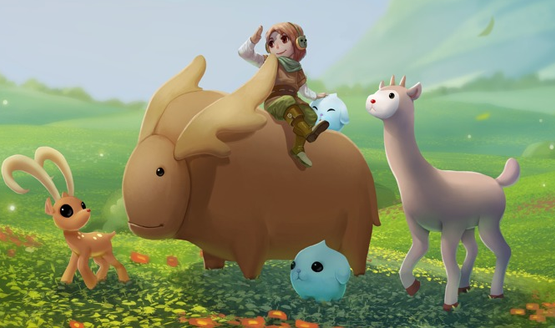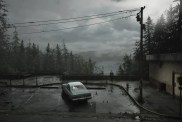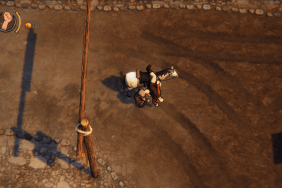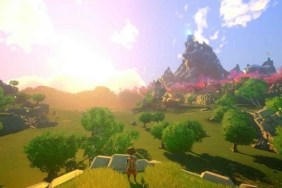Yonder: The Cloud Catcher Chronicles is an adorable indie title, made by a small team and supported by the incredible audio design of audio engineer and composer Stephan Schutze. We got a chance to sit down with Stephan to pick his brain about the Yonder audio design and sound composition in games, something he’s clearly got an immense passion for. Buckle up, this is a long one, but well worth the read if you’re interested in some of the behind-the-scenes secrets that go into making the games you play sound as good as they do.
PSLS: Hi Stephan! You are the sound designer- You did the soundtrack and everything for Yonder, correct?
Stephan: Essentially I’ve been doing stuff in the industry for quite a long time, and often when I do indie projects, I will quite often do the whole audio, essentially.
PSLS: When you come in and you’re taking on everything, you’re not just the composer, but you’re also working with the sound effects, are you able to make those work together in a way that larger studios don’t, because you can kind of synergize the two a bit more?
Stephan: I think it is an advantage, and it’s been an interesting thing because I started in the industry 18 years ago. That was one of those weird stories you hear where you get a gig and you weren’t really sure what was going on. I thought I was being hired back then as a composer and I turned up and they said ‘No, you’re doing everything. You’re doing all the audio,’ and I’m like ‘Uhhh, okay! Great!’ I sort of had to teach myself sound design, but it was interesting.
While it was difficult in one regard because there’s a lot of work to be done, the flip side is exactly what you’ve said. It gives you quite an advantageous ability to blend everything together in a really lovely way. By the time –eighteen years on — I get around to something like Yonder, it gives me the ability to quite literally craft the whole audio world by looking at things and going ‘Okay, I’ve decided where I’m going to have these ambient sounds and birds and insects, etc.’ and I’ve decided how the music is going to go in. It is quite a privileged situation in some ways.
I remember hearing an interview with Danny Elfman many years ago about all the film music he’s done, and the interviewer asked a question that I really don’t think she was expecting the answer she got. She said ‘Danny, when you see a movie with your music in it, how do you feel?’ She was obviously expecting him to say ‘Oh, it’s wonderful! etc.’ but Danny just looked at her and said ‘Somewhere between depressed and suicidal.’ She asked him to explain and Danny Elfman explained that he’s asked to write all this beautiful music and he puts his heart and soul into writing this music, and then what happens is the process of getting it into a film. It means that they will edit it, they’ll just cut the music because the film has changed.
He’s written the music to this film, and at the last minute they’ll have to edit the film so the music sometimes just cuts, or he’s written a beautiful passage and there’s an explosion over the top of it, and all these sorts of things that obviously, for him, was very, very disappointing. He had put all this effort into writing the music, but not quite the same level of control over when and how it would be utilized.
When you flip it back to the situation that I have, whilst obviously it can be a huge challenge and kind of stressful to have to create everything, I’ve at least got that knowledge that I know what’s going to happen next. I know that if I put that piece of music in here, this a particular forest where there’s lots of noisy things going on, etc. So knowing that, I can craft the music to fit the sound design if the sound design is more important. Or flip that over, and if there’s an emotional thing that’s going to happen, and we want the music to lift up because it’s going to tug on the heart strings, I get to play with the sound here and can bring the sound down a little bit.
In the film industry, there would probably be half a dozen people combined doing what quite often one person does in the game industry. The challenge of having to get all that work done gets balanced out by the fact that you get to craft something a little bit more in the whole form.
PSLS: Did you have a lot of interaction, collaboration, and input on Yonder outside of the sound design when you were working with the team? Did you get to influence any other factors?
Stephan: The team was amazing, and probably one of the best teams I have ever worked with. The core team is three people. Joel, who is the main passion behind the whole thing, started as an artist, and then became a technical artist, and taught himself programming. He not only did the art, but a very large chunk of the programming as well. The whole basic demo he created by himself, which is incredible. The beauty of a small team meant that everybody was invested in what was going on. That’s an advantage to indies over the big studios.
A lot of the big studios don’t have the infrastructure to get everybody’s feedback. Democracy doesn’t work for game development. I’m not suggesting that the Yonder team was democracy, but it was still one where there was passionate feedback from all the people involved. Having a small team, everybody cared. Everybody was able to make suggestions. There might have been an area where I said ‘Hey, we could do this,’ and they were like ‘Alright, yeah, let’s think about how that might work.’ There was a discussion backwards and forwards.
In some cases where the potential of the music or the sound might influence what was going on, those sorts of things would be taken into consideration. There were also times when it was like ‘Wouldn’t it be great if we could do X, Y, and Z?’ and some of those things got adopted and some did not. In bigger studios, it can’t happen when you’ve got 100 people working on a project. It’s very, very difficult.
PSLS: Yonder is a unique game in that there isn’t any violence. It’s about exploration and discovery of the world. How did you approach the music and sound to promote that feeling? You don’t have any big battle scenes with epic music. How did you use sound design to fill out the world?
Stephan: First was the discussion about music. I almost turned down working on Yonder, and I’m very glad that I didn’t. At the time I was incredibly busy. I’d just finished working on another project, and Cheryl Vance, the producer on Yonder, got in touch with my wife and asked if I would be interested in working on Yonder, and they sent through the demo. I was incredibly busy and I said ‘Oh, okay, I’ll have a look at this,’ and looking at the demo thought it was really, really pretty, even at the demo stage, but I thought ‘oh, I’m so busy.’
I was kind of looking for excuses to potentially not work on it. I thought that if I took on too much, I couldn’t do as good a job as I would like to. That’s very important to me. I treat even the smallest jobs as being a triple-A project. So even one smaller jobs where I’m not being paid very much, doing all those extra little steps, sometimes I just need to tell myself ‘No, just move on.’
Yonder was a big enough thing that I would have to treat it very seriously. It came down to one question in my head. I wanted to try a particular style of music that was very important to me, that I have been heavily influenced by. I thought that I would ask them, and give them the chance to say that’s not what they’d want, it would give me the excuse to say ‘Thanks but no thanks.’
So I sat down with Joel and we had a good talk, and I said I had one last question. I said ‘Look, I’ve got a style and composer in my head that I would love to do, but I would like to know what you have in mind. So what do you want for your musical style for this?’ and he said ‘Well we want a very innocent, joyous style of music. We want music in the style of Studio Ghibli and Miyazaki style films.’
That was the exactly the style I had in my head, so there was no possible way I couldn’t work on this project. Initially, it was far harder to pin down because I understood the whole idea of simple, innocent beautiful style music, but the first pieces of music I did, the feedback I got back — which was 100% accurate — was ‘Yeah, I think you’re sounding a little bit too Disney, and not enough Ghibli.’ Slowly there was this evolution. What is Disney and what is Miyazaki? Disney has more harp runs [mimics a harp] and tinkly little bells and stuff like that, whereas Ghibli did not.
Slowly we evolved it that way. The whole world was one of wonder and one of joy. The fact that i couldn’t have giant, stomping, Hans Zimmer, Batman sort of notes never came into it. It was never about having a giant powerful orchestra playing the final boss fight because the challenges in trying to create something that was always joyous and delightful– even at nighttime, there was never anything that was scary or ominous. This became a massive challenge in itself.
I’ll cite an example in Ponyo, which is a Studio Ghibli film. There’s a character that comes out of the ocean in front of a little boy, and she’s sort of part fish or whatever, and I remember seeing this. I wasin Tokyo the day that film came out, and we saw it in Japanese. I couldn’t understand exactly what was being said, but it didn’t matter. There was one scene in the movie where the camera angle looked like it was set up for something ominous to happen and I was waiting for the music to change, and then I thought ‘No, this is a Ghibli film. There’s not going to be anything evil or dangerous there, because that’s not what’s going to happen.’
That has stayed with me ever since. Nighttime needed to be calm and beautiful and safe. how do you write music for night that doesn’t have any of the cliche things? In every film and game that we’ve ever seen, it’s basically the sun goes down and the music is kind of like ‘Is there a zombie out there?’ Even if it’s supposed to be a safe thing, often nighttime for humans is– we can’t see as well. We don’t know what’s in the shadows. We get really freaked out by it. So it was a real challenge through the music to convey at all times to the player ‘It’s okay! You’re safe!’ It’s just a different adventure. It’s not a bad adventure, it’s just a different adventure.
All the night ones I kind of treated like a lullaby for a child, like it was singing to a child at nighttime to let it know that it was safe, and it was warm, and it was comfortable. So nighttime was obviously much softer, and much calmer, and all the sounds were as well. Things like crickets that you like to hear, and all the cute animals would have cute snores and stuff like that. These big fluffy Groffles would be snoring and weezing away. Nighttime was supposed to be ‘awwhhh,’ not ‘gahhhh!’ This was a balancing act of bringing everything down, but preserving the sense of innocent wonder.
We talk to Stephan and secrets of the trade for recording sound effects on the next page.








